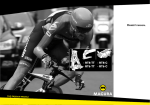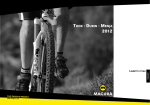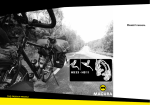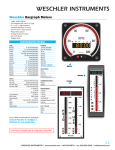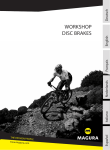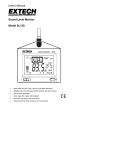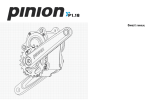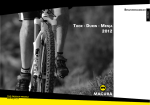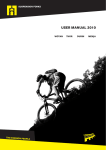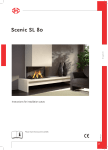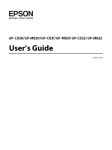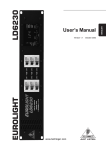Download Magura TS8 R
Transcript
TS8 · TS829 TS6 · TS629 THE PASSION PEOPLE www.magura.com Owner's manual Contents Diagrams Introduction Preface................................12 Legend................................12 Technical Specifications Specifications.....................13 Dimensions.........................13 English Safety Intended use.......................14 Basic safety instructions.....14 Installation Installing the suspension . fork.....................................16 Fit the front wheel...............17 Fit the remote control lever (RCL²)..................................18 SetUp Air pressure guidelines.......20 Adjusting the suspension . (air pressure).......................20 Adjusting the damping (rebound damper)...............21 Adjusting the damping (compression damper)........22 Before each trip..................22 On the Road Locking out the suspension fork – DLO².........................23 Locking out the suspension fork – Albert Select+...........23 Reducing the suspension travel – Lift Select...............23 Maintenance After each trip.....................24 Regular................................24 Rules Warranty.............................25 3 Diagrams A1 1 2 THE PASSION PEOPLE www.magura.com Diagrams TD 1⅛" 1⅛"/1.5" tapered 1.5" Ø 28,6 mm Ø 28,6 mm Ø 38,1 mm Ø 30,0 mm Ø 39,8 mm Ø 39,8 mm A B MAGURA M15 MAXLE ™ QR C Ø 15 mm D Ø 15 mm Ø 9 mm Diagrams B1 B2 V 1 S A1 L H A2 B3 C1 25 mm max.! THE PASSION PEOPLE www.magura.com Diagrams D1 D2 3 2 1 D3 E1 2 4 1 Diagrams F1 3 F2 7 9 5 5 6 6 4 2 1 8 9 F3 F4 12 10 11 THE PASSION PEOPLE www.magura.com Diagrams G1 G2 1 G4 0 20 G3 A B 4 2 3 5 sag 20–30 % Diagrams H1 H2 H3 H4 THE PASSION PEOPLE www.magura.com Diagrams H5 J1 J2 Introduction Introduction Preface Welcome to the PASSION PEOPLE, Congratulations on your purchase of the latest generation MAGURA suspension fork – developed in Germany. This User Manual is an integral part of your MAGURA product and gives you details of the required tools, correct installation, safe use, maintenance and setup options. Please read this manual carefully before you install or use your MAGURA product. Always observe and follow all instructions on installation, use and maintenance provided in this manual and in manuals by third-party manufacturers whose products you use on your bicycle (headset, stem, wheels, brakes, etc.). Remember that the mechanic who installs your MAGURA product is responsible for the suitability and compatibility of all the components technically linked to your MAGURA product. Legend )) The pointing finger prompts you to perform an action. ÎÎ The arrow shows results or requirements. LLThis notice gives you additional information or tips. refers to an item number in the graphic area – e. g. Item ô. [B2] refers to a diagram in the graphic area – e. g. Figure B2. (3) This notice warns you about a dangerous situation which can lead to serious or fatal injury if not avoided. This notice warns you about a dangerous situation which can lead to minor or slight injury if not avoided. This notice warns you about the risk of material damage. Failure to observe the instructions in this Manual can lead to serious or fatal accidents. You can find the diagrams that this manual refers to in the folder in the front cover. The figures in this Manual may differ slightly from your MAGURA product, however, the required steps are the same for all types and variants – if not stated to the contrary. The type name (1) and variant (2) of your MAGURA suspension fork are located on the sliders on the lower leg [A1]. Please note that the geometry and riding behaviour of your bicycle may change due to installing a new suspension fork. During the first few rides using your new MAGURA suspension fork, familiarize yourself with those characteristics of your bicycle (cornering, sag, braking, etc.), which may have changed. 12 Keep this manual for other users of your MAGURA product. Make sure that each user reads, understands and observes this manual. If you sell or give away your MAGURA product, be sure to hand over this manual to the new owner. Visit www.magura.com for more tips and information on your MAGURA product. You can also exchange experiences, ask questions and generally “talk shop” with many PASSION PEOPLE members on the MAGURA Forum. We wish you great success and a great ride Your MAGURA Team THE PASSION PEOPLE www.magura.com Technical Specifications Technical Specifications LLSome of the features detailed are optional variants. . Your MAGURA suspension fork is equipped as designed by your dealer or the bicycle manufacturer. Specifications TS8 / TS829 TS8 Type name Variant Suspension travel reduction (Lift Select)* R 150 ca. -20 % R140 – R120 ca. -30 %** R100 R80 Damping Albert Select+ • DLO² AllMountain Applications Albert Select+ • DLO² X120 Albert SL X100 X80 DLO² XC, XC Race XC Race 130 (286) kg (lb) Total weight max.*** SL80 Air 10 (150) Oil bar (psi) Pressure level control SL100 – Suspension Air pressure max. SL120 TS6 / TS629 Dimensions Variant [TD] Steerer (A) Suspension travel (B) Height (C) TS TS29 Rim brake bridge** Disc brake bridge Ø Brake disc min.–max. Tire dimension max. TS8 / TS829 TS8 Type name TS TS29 TS TS29 TS TS29 Installation dimensions hub (D) TS Quick release system TS29 * Depending on the air pressure. ** Not with TS29. R 150 R140 R120 R100 mm mm (in) 150 (5.9) 140 (5.5) 120 (4.7) 100 (3.9) 530 520 493 473 mm ±3 – 530 510 – Postmount 7" – 180–210 mm – 26 × 2.6 (62-559) – mm Maxle™ [TD] – R80 SL120 SL100 SL80 1⅛" • 1⅛"/1.5" tapered • 1.5" 255 80 (3.1) 120 (4.7) 100 (3.9) 80 (3.1) 453 493 473 453 490 530 510 490 Cantilever Postmount 6“ Postmount 7“ 160–210 180–210 26 × 2.4 (60-559) 29 × 2.4 (60-622) 100 QR MAGURA M15 TS6 / TS629 X120 X100 120 (4.7) 100 (3.9) 493 473 530 510 X80 80 (3.1) 453 490 *** Maximum permitted total weight = rider + bicycle + luggage 13 Safety Safety Intended use Any use other than the intended use can lead to accidents that cause serious or fatal injury. MAGURA TS8 and TS6 suspension forks are designed and intended only –– for installation on standard, commercially available bicycles designed for 26" wheels. –– for use with a 26" front wheel and the specified quick release system – see Dimensions, page 13 MAGURA TS829 and TS629 suspension forks are designed and intended only –– for installation on standard, commercially available bicycles designed for “29er” wheels. –– for use with a “29er” front wheel and the specified quick release system – see Dimensions, page 13. MAGURA suspension forks are designed and intended only –– for use with the specified brake system – see Dimensions, page 13. –– for the specified application – see Specifications, page 13. –– for the maximum permissible total weight – see Specifications, page 13. MAGURA suspension forks must never be used in combination with front wheel motors! Basic safety instructions Always remember that riding a bicycle entails risk both for the rider and other road users, and for the bicycle and its components. Despite the use of safety gear and complete safety equipment, accidents that cause serious or fatal injury can occur. Always use your common sense and avoid any unreasonable actions! Installation & Maintenance Danger of accident due to damaged suspension fork caused by incorrect or impermissible installation work. –– Never overestimate your technical capabilities. Commission a bicycle workshop or an authorized MAGURA service centre with all installation and maintenance work. This is the only place where you are guaranteed correct implementation. –– Never make changes to your MAGURA product (e.g. tapping thread on the steerer, milling the disc brake bridge, removing the hanger on the dropouts, drilling, painting, etc.). –– Always observe all min./max. values stated – see Technical Specifications, page 13. –– For assembly steps that require a specific tightening torque for a screw union, always use a torque wrench set up for the required torque. –– Always maintain your bicycle in technically perfect working order. Danger of accidents due to improper accessories. –– Always use MAGURA original parts and lubricants. –– Never install mounting clips, luggage carriers, mudguards or similar on your MAGURA suspension fork. . If needed, fit a MAGURA approved mudguard. 14 THE PASSION PEOPLE www.magura.com Safety On the road Danger of accidents due to component failure. –– Before each trip, make sure that the quick release system on your wheels is fitted correctly and that your wheels will not work loose. –– Before each trip, make sure that the handlebar and stem are correctly fitted and will not twist. –– Before each trip, work the suspension multiple times to make sure that your MAGURA suspension fork is leak tight and shows no sign of oil leaks on screws, sliders and seals, or any other visible mechanical damage. –– Before each trip, make sure that your brakes are working properly and that the brake pad thickness is sufficient. –– Never exceed the maximum permissible total weight – see Specifications, page 13. –– During riding, avoid uncontrolled hard dipping/bottoming out of your MAGURA suspension fork. –– After a crash, check your MAGURA suspension fork for signs of damage and perfect function. –– Never use your MAGURA suspension fork in case of visible damage, unusual noise, or if you are unsure as to their condition. In this case, have your suspension fork checked in a bicycle workshop or directly by MAGURA Service. aged helmet and clothing that fits snugly but does not impair your actions. –– Only ride your bibicycle if you are in good physical condition and your bibicycle and all of its components are in perfect working order. Transport & Storage Danger of accident due to damaged components. –– Never transport your bibicycle using vehicle bicycle carriers that require you to secure the fork by its dropout without the front wheel. –– Always install a suitable spacer between the dropouts on your MAGURA suspension fork if you stow your bibicycle with the wheels removed (transport bag, carton, etc.) Danger of accidents due to improper behaviour or improper equipment during riding. –– Never use your MAGURA suspension fork for downhill, freeride, free- style applications, or other disciplines that involve jumping with the bicycle, or where extreme loads are to be expected. –– Always observe the traffic regulations in the country where you are riding (lighting, reflectors, etc.) and the local regulations relating to mountain biking. –– When riding, always wear a high quality (e.g. ANSI certified), undam15 Installation Installation Installing the suspension fork )) Make sure that the frame, headset, stem, and adjusting nut match the steerer on your suspension fork – see Technical Specifications, page 13. Shortening the steerer Suspension fork unusable due to over-shortened steerer. –– Measure carefully and check the calculated length before cutting. –– Originally allow for 1 additional spacer – you can always shorten again, but you can’t extend! Correct calculation of length L of your steerer [B1]: A1 upper height A2 lower height H Height of steerer (frame) S Total height of spacers V Height (tube clamp) stem L = (A1 + A2 + H + S + V) – 2 mm )) Use a sharp, finely toothed metal saw, or pipe cutter, to shorten the steerer to the required length – deburr. Fitting the headset Damage to the suspension fork. –– When installing the bearing seat and adjusting nut do not rest the suspension fork on the dropouts. )) Using a suitable installation aid, tap the adjusting nut carefully and straight into the steerer [B3]. Installing the suspension fork )) Install the suspension fork with headset components, spacers and stem. )) Adjust the headset so that it is free of play. )) Align the stem straight. )) Tighten the clamping screws on the stem with the tightening torque stated by the manufacturer. Fit the brake )) Make sure that the front wheel brake dimensions and type match your suspension fork – see Technical Specifications, page 13. LLSecure the front wheel brake with a low tightening torque at first. Gran- ular adjustment and final installation with clean routing and possibly shortening of the brake tubing is performed with the front wheel fitted. Danger of accident due to damaged components. –– Never exceed the maximum tightening torques of the fastening screws: –– Disc brake body (Postmount) max. 10 N·m (89 lbf·in). –– Cantilever brake max. 6 N·m (53 lbf·in). )) Secure the brake tubing for the front disc brake with the tubing guide [C1]. )) Tighten the screw on the tubing guide with a tightening torque of max. 2 N·m (18 lbf·in). Increased bearing wear. –– Make sure that the lower bearing seat lies totally flat and flush against the headset. )) Grease the bearing seat (1) [B2] and steerer contact area. )) Using a suitable installation aid tap the bearing seat into its position on the steerer – rotate the steerer through 5–10° after each tap. 16 THE PASSION PEOPLE www.magura.com Installation Fit the front wheel )) Push the Maxle™ axle from the right through the dropout and hub axle. Danger of accident due to front wheel blocking because of faulty installation work. Danger of accident due to damaged components. –– Make sure that a minimum gap of at 2 mm exists between rotating parts (hub, fastening screws on the brake disc, etc.) and the suspension fork. Replace the parts if needed. –– Make sure that the brake cable can never touch the tire. –– Make sure that, when fully depressed, your suspension form has a minimum clearance of 6 mm between the tire and the crown. Replace the tire if needed. –– Make sure that the front wheel brake system is correctly fitted and adjusted. Danger of accident due to quick release system failure due to impairment through soiling. –– Whenever you install the front wheel, make sure that the dropouts on your suspension fork and all the parts of your quick release system are clean. Danger of accident due to faulty installation work. –– MAGURA type TS829 or TS629 suspension forks must be combined exclusively with the MAGURA M15 thru axle clamping system. )) Make sure that the dimensions and type of the front wheel hub, wheel, quick release system and brake disc match your suspension fork – see Technical Specifications, page 13. )) If applicable mount the brake disc on the front wheel hub. … using the Maxle™ thru axle clamping system )) Insert the front wheel into the dropouts (1) on your MAGURA suspen- sion fork – check for correct direction of rotation. )) Open the clamping lever (2) on the Maxle™ axle (OPEN) and place in the groove of the contact plate (3) [D1]. –– Never use tools when installing the Maxle™ axle. –– Never turn the clamping lever in closed state. )) Using the clamping lever, screw the Maxle™ axle clockwise into the left dropout on your suspension fork until it is hand tight. )) Close the clamping lever (CLOSE). ÎÎ The clamping lever points horizontally to the rear and you can see the CLOSE mark [D2]. LLIf the clamping lever does not point horizontally to the rear, open the lever, turn it – but not the contact plate – horizontally to the front, and close it again. LLYou must be able to close the clamping lever by applying moderate pressure, approx. 15–20 kg (33–44 lb) by hand. . If you only sense slight resistance when closing the clamping lever or the clamping lever doesn’t leave a clear imprint on your palm, you will need to increase the tension of the Maxle™ thru axle quick release system.. Gradually approach the correct tension by turning the adjusting screw (Allen, SW 2.5 mm) through one click [D3]! )) Open the clamping lever (OPEN). )) Turn the adjusting screw (4) in clockwise direction. ÎÎ The tension of the Maxle™ thru axle quick release system increases. or: )) Turn the adjusting screw (4) in counter-clockwise direction. ÎÎ The tension of the Maxle™ thru axle quick release system decreases. )) Close the clamping lever (CLOSE). LLIf you are unsure as to the correct tension for your Maxle™ thru axle quick release system, ask your bibicycle mechanic for advice. 17 Installation … using traditional quick release Fit the remote control lever (RCL²) LLYou will notice that DLO² or Albert Select+ are suitable for remote Danger of injury on sharp and/or hot brake disc when removing the front wheel. –– Always mount the clamping lever on the front wheel quick release on the right-hand side. LLInstalling the clamping lever on the right can also reduce brake disc squeal. )) Centre the front wheel precisely in the dropouts of your MAGURA sus- pension fork – check for correct direction of rotation. )) Adjust and close the quick release in line with the manufacturer’s manual. … using the MAGURA M15 thru axle clamping system Danger of accident due to faulty installation work. –– MAGURA M15 must be combined exclusively with the MAGURA type TS8 or TS6 suspension forks. 29 29 )) Insert the front wheel into the dropouts (1) on your MAGURA suspen- sion fork – check for correct direction of rotation. )) Push the MAGURA M15 axle from the right through the dropout and hub axle [E1]. )) Screw the MAGURA M15 axle clockwise handtight into the left dropout of your suspension fork. )) Tighten the MAGURA M15 axle with a tightening torque of 15 N·m (133 lbf·in). )) Insert emergency tool (2) into the MAGURA M15 axle from the left. LLFamiliarize yourself with the force required to reach the required tight- ening torque. This will allow you to tighten your front wheel securely without a torque wrench even when you are away from home. 18 control because the blue dials are returned to their original position by a return spring if turned by hand. Blue dials that do not have a return spring do not support remote control with RCL²! However, retrofitting is possible at a MAGURA service centre.. Lift Select can be operated both via RCL² and directly. Danger of accident due to faulty installation work. –– Make sure that the RCL² cannot interfere with brake and gear shift actuation and function in any lever position. Damage to material due to faulty installation work. –– Never fit the clamps in the wider area of the handlebar. –– Never exceed the maximum tightening torques. There are 3 different fastening options for the RCL² [F1]: –– Standard clamp (1) – for fitting next to the brake lever. –– Standard clamp with spacer (2) and long clamping screw (3) – for fitting next to the brake lever in combination with twist shifters. –– Remote mix clamp (4) – only for direct fitting to brake levers of MAGURA MT Series and HS Series (MAGURA rim brakes) as of model year 2011. LLFit RCL² for Lift Select on the left; and for DLO²/Albert Select+ on the right [F2]. )) Define the position of the standard clamp on the handlebar. ÎÎ Make sure that the brake and gear shift actuation and function is not impaired in any RCL² lever position. ÎÎ The lever (5) and return dial (6) on the RCL² must be easily reachable. )) Tighten the clamping screw (7) (3) on the standard clamp with a tightening torque of max. 3 N·m (27 lbf·in). THE PASSION PEOPLE www.magura.com Installation )) Tighten the sleeve nuts (8) on the Remote Mix clamp with a tightening torque of max. 3 N·m (27 lbf·in). Fit the RCL² Bowden cable Danger of accident due to faulty installation work. –– Make sure that the Bowden cables on the RCL² can never interfere with steering. ÎÎ The outer sleeve must be laid via the shortest route, without torsion or kinking, between the stops on the (9) RCL² and the crown [F2]. )) Shorten the outer sleeve of the Bowden cable with suitable Bowden cable pliers. )) Make sure that the lever on the RCL² is relieved – press the return dial if necessary. )) Feed the inner cable through the RCL², outer sleeve and stop on the crown. )) Make sure that the outer sleeve is firmly seated in the stops. Fit the inner DLO²/Albert Select+ cable [F3]: )) Pull the “Albert Select+” adjusting dial off in upward direction or remove the cover on the “DLO²” by unscrewing counter-clockwise. )) Loosen the clamping screw (10) by 2–3 turns. )) Tension the inner cable and insert it into the groove on the rotating dial and under the washer on the clamping screw and hold in place. )) Tighten the clamping screw with a tightening torque of max. 2 N·m (18 lbf·in). )) Trim the inner cable to a length of approx 2 cm after the clamping screw. )) Push the end of the inner cable through the cutout into the inside of the rotating dial. )) Press in the “Albert Select+” adjusting dial or replace the cover on the “DLO²” by screwing it on clockwise. Fit the Lift Select inner cable [F4]: )) Loosen the clamping screw (11) (12) by 2–3 turns. )) Tension the inner cable and insert it into the groove on the rotating dial and hold in place. )) Tighten the clamping screw (11) with a tightening torque of max. 2 N·m (18 lbf·in). )) Trim the inner cable to a length of approx. 3 mm after the clamping screw (12). )) Tighten the clamping screw (12) with a tightening torque of max. 2 N·m (18 lbf·in). )) Retension the inner cables after the first 10–20 actuations. 19 SetUp SetUp Before you go for your first ride with your new MAGURA suspension fork, take some time to adjust the suspension and damping to match your personal weight and style of riding. This is absolutely necessary to make best use of your suspension fork’s characteristics. LLNote that the specified air pressure values are for reference only. You should adjust them for your personal riding style, your seating position, the characteristics of the road, and the geometry of your bicycle. kg 50–59 60–69 70–79 80–89 90–99 100–109 110–119 120–130 lb 110–124 125–149 150–174 175–199 200–224 225–249 250–274 275–286 –– Never use your suspension fork if there is insufficient or no air pressure. Air pressure guidelines Rider’s weight Material damage due to severe bottoming out caused by insufficient air pressure. Air pressure bar (± 0,5) psi (± 7) 3,5–3,9 50–52 4,0–4,3 53–60 4,4–5,0 61–70 5,1–5,6 71–78 5,7–6,3 79–85 6,4–7,0 86–99 7,1–8,0 100–114 8,1–8,9 115–126 Material damage due to excessive air pressure. –– Never exceed the maximum permissible air pressure of 10 bar (150 psi). Air leaking due to incorrect fitting of the valve cover. –– Never use the suspension fork without a valve cover. –– Always keep the valve cover seals clean. –– Always firmly close the valve cover. )) Make sure that Albert Select+ or DLO² is disabled (off) [G1]. )) Make sure that Lift Select is set to the maximum suspension travel (MAX) [G2]. )) Remove the valve cover (1) by turning counter-clockwise. )) Shift the lever (2) on the pump head to the upper position (Position A) [G3]. )) Screw the union nut (3) on the pump head onto the valve until hand tight. )) Shift the lever (2) on the pump head to the lower position (Position B). Adjusting the suspension (air pressure) LLThe air suspension on your MAGURA suspension fork helps to compen- sate for uneven terrain and keeps your front wheel in contact with the ground at all times.. Insufficient air pressure causes a pronounced drop, frequent bottoming out and a spongy ride.. Excessive air pressure reduces the maximum suspension travel and provokes a hard response from your suspension fork.. As a general rule, the higher your weight and speed, and the rougher the terrain, the higher the air pressure will need to be. 20 ÎÎ The valve pin is pressed in; the valve is open. can read off the current pressure on the pump pressure gage. )) Adjust the air pressure if needed. LLPushing the ventilation button (4) fully gradually reduces the pressure. Pushing the ventilation button lightly completely evacuates the pressure. )) Shift the lever (2) on the pump head to the upper position (Position A). ÎÎ The valve pin is released; the valve is closed. ÎÎ No loss of pressure when you remove the union nut. )) Remove the union nut. ÎÎ You THE PASSION PEOPLE www.magura.com SetUp Check the air pressure LLThe negative suspension stroke – or sag – designates the distance by which your suspension fork drops if you apply your own bodyweight to it; this gives you some initial feedback as to whether the air pressure setting is in the right range. )) Push the rubber ring (5) [G4] on the left stanchion right down. )) Make sure that Albert Select+ or DLO² is disabled (off) [G1]. )) Make sure that Lift Select is set to the maximum suspension travel (MAX) [G2]. )) Mount your bike carefully – don’t bob up and down. ÎÎ The suspension sag will depend on your bodyweight. )) Carefully dismount. )) Measure the distance between the rubber ring and the scraper. ÎÎ The sag should be 20–30 % of the total possible suspension travel on your suspension fork – see Dimensions, page 13. )) Increase the air pressure if the sag is above 30 %. )) Reduce the air pressure if the sag is below 20 %. LLTo finely adjust the air pressure in your suspension fork, you will need to go for a trial run on a typical test route. )) Increase the air pressure if the suspension bottoms out more than 1 or 2 times. )) Reduce the air pressure if your suspension fork don’t achieve the potential stroke (you can see this by checking the final position of the rubber ring). Adjusting the damping (rebound damper) LLThe rebound damping setting defines the speed at which your MAGURA suspension decompresses. . A high rebound damping setting (+) causes slower decompression thus reducing ground contact and possibly impairing traction and control. . Lower rebound damping (-) causes the front wheel to jump and can thus also impair traction and control. . As a general rule, the higher your bodyweight and speed, and the rougher the terrain, the higher the rebound damping will need to be. )) Make sure that Albert Select+ or DLO² is disabled (off) [G1]. )) Start by turning the red adjusting dial counter-clockwise to the stop (-) [H1]. )) Turn the red adjusting dial 6–7 clicks in clockwise direction (+). ÎÎ This sets the rebound damping to an average value. LLA short test is necessary for granular adjustment of the damping: while sitting on the saddle, ride off a low step (curb or similar). )) Increase the rebound damping gradually by 1 click (+) – if the suspension rebounds more than 1 or 2 times. )) Gradually reduce the rebound damping by 1 click (-) – if your suspension decompresses too slowly. 21 On the Road Adjusting the damping (compression damper) Before each trip LLThe compression damping of all MAGURA suspension forks is factory set and cannot be changed. . However, with Albert Select+ enabled, you can preset the compression damping on your MAGURA suspension to suit your own needs. . High compression damping (+) causes slower suspension deflection, which reduces sag and/or reduces the sensitivity of the suspension when you stand on the pedals.. Lower compression damping (-) causes more sensitive deflection, thus causing more frequent sag of the suspension fork when standing on the pedals. )) Make sure that Albert Select+ is enabled (on) [H2]. )) Start by turning the golden adjusting dial counter-clockwise to the stop (-) [H3]. )) Then turn the golden adjusting dial approx. 3 turns in clockwise direction (+). ÎÎ This sets the compression damping to an average value. LLTo finely adjust the compression damping (Albert Select+), you will need to go for a trial run on a typical test route. )) Gradually increase the compression damping (+) – if your fork sags too frequently or too pronouncedly when standing on the pedals, or if you want to reduce the sensitivity. )) Gradually reduce the compression damping (-) – if your fork deflects too slowly, or if you want to increase the sensitivity. LLThe Albert Select+ preset, set on the golden dial, has no effect if Albert Select+ is disabled (off). In this case your suspension fork is fully activated. 22 On the Road SetUp Danger of accidents due to component failure. –– Before each trip, make sure that the quick release system on your wheels is fitted correctly and that your wheels will not work loose. –– Before each trip, make sure that the handlebar and stem are correctly fitted and will not twist. –– Before each trip, work the suspension multiple times to make sure that your MAGURA suspension fork is leak tight and shows no sign of oil leaks on screws, sliders and seals, or any other visible mechanical damage. –– Before each trip, make sure that your brakes are working properly and that the brake pad thickness is sufficient. –– Never use your MAGURA suspension fork in case of visible damage, unusual noise, or if you are unsure as to their condition. In this case, have your suspension fork checked in a bicycle workshop or directly by MAGURA Service. )) Make sure that Albert Select+ or DLO² is disabled (off) [G1]. )) Deflect the suspension multiple times with the front wheel brake on. ÎÎ The damper unit is reliably flooded with oil. damping unit on the suspension fork will now work reliably from the start of your ride. )) Make sure that the suspension fork respond perfectly and with sufficient sensitivity. . If needed, do some “minor service work”. . See the maintenance guide on www.magura.com >>> service >>> downloads. )) Check the air pressure – see Adjusting the suspension (air pressure), page 20. ÎÎ The THE PASSION PEOPLE www.magura.com On the Road Locking out the suspension fork – DLO² Reducing the suspension travel – Lift Select LLActivating Dynamic Lockout DLO² saves energy riding uphill. This sets LLLift Select reduces the suspension stroke on your MAGURA suspension the compression damping to the maximum value. Your MAGURA suspension fork will hardly deflect when you stand on the pedals. )) Enable DLO² (on) [H4]. ÎÎ The negative suspension stroke – or sag – is kept. ÎÎ This improves ground contact compared with fully locked fork. LLYour suspension fork will still buffer and damp hard knocks in enabled state, if you forget to disable (off) before riding downhill. fork by up to 20 % (TS8 R 150) or 30 % (TS8 R 120) – depending on the air pressure. However, your suspension fork will still give you fully active response despite reduced travel. )) Set Lift Select to reduced suspension stroke (MIN) [H5]. )) Briefly apply a load to the handlebar (e.g. ride over an obstacle). ÎÎ Reduced suspension travel is active. LLIf your bicycle is not equipped with the RCL² remote control lever, and you need to actuate Lift Select directly, turn the dial through its snap-in point to the stop. . If you use RCL², the setting is performed via the remote control lever; the dial will stop shortly before its snap-in point. . There is no difference with respect to suspension travel reduction. Locking out the suspension fork – Albert Select+ LLThe compression damping of all MAGURA suspension forks is factory set and cannot be changed. . However, with Albert Select+ enabled, you can preset the compression damping on your MAGURA suspension to suit your own needs – see Adjusting the damping (rebound damper), page 21. Enabling Albert Select+ (on) and turning the golden dial clockwise (+) to the stop will help you save the most energy riding uphill. This sets the compression damping to the maximum value. Your MAGURA suspension fork will hardly deflect when you stand on the pedals. )) Enable Albert Select+ (on) [H2]. ÎÎ The negative suspension stroke – or sag – is kept. ÎÎ This improves ground contact compared with fully locked fork. LLYour suspension fork will still buffer and damp hard knocks in enabled state, if you forget to disable (off) before riding downhill . )) Set Lift Select to the maximum suspension stroke (MAX) [H5]. )) Briefly relieve the handlebars. ÎÎ Full suspension travel is now available. LLThe Albert Select+ preset, set on the golden dial, has no effect if Albert Select+ is disabled (off). In this case your suspension fork is fully activated. 23 Maintenance Maintenance )) Clean the suspension fork with water, detergent and a brush. Danger of accidents due to pressurised parts. –– Never open your MAGURA suspension fork via the top screws in the crown or the screws at the bottom end of the stanchions. Contact your authorised MAGURA service centre if your suspension fork needs a major service. This is the only place where you are guaranteed correct implementation. LLVisit www.magura.com >>> service >>> downloads for a mainte- nance guide for your MAGURA suspension fork in PDF format. The guide gives you step by step instructions for easier maintenance work that you can perform on your suspension fork yourself. After each trip )) Clean the stanchions with a clean, dry cloth [ J1]. Increased wear on seals due to soiling. –– Do not apply lubricants to the stanchions. Regular )) Make sure that Albert Select+ or DLO² is disabled (off) [G1]. )) Deflect the suspension multiple times with the front wheel brake on. )) Make sure that the suspension fork respond perfectly and with suffi- cient sensitivity.. If needed, do some “minor service work”. . See the maintenance guide on www.magura.com >>> service >>> downloads. )) Check the air pressure – see Adjusting the suspension (air pressure), page 20. )) Check the tension and ease of operation of the RCL² inner cables – make sure that the corresponding dial immediately responds to you actuating the RCL² – see Fit the RCL² Bowden cable, page 19. LLMAGURA suspension forks have internal permanent lubrication and excellent sealing material so that very little maintenance work is required for the internal components. Once a year, you will need to have your MAGURA suspension fork serviced in a professional bicycle workshop or by an authorised MAGURA service centre.. If you are a frequent user, also consider the fact that this exposes your suspension fork to more wear and thus requires more frequent maintenance intervals and checks. LLHow frequently you need to maintain your MAGURA suspension fork depends on how often you use it, but also on weather influences. Perform the following maintenance steps more frequently if you use your bicycle in extreme conditions (rain, dirt, high mileage, etc.). Corrosion and material damage due to water penetration. –– Never use a pressure or steam cleaner to clean your bicycle – the seals on your bicycle components are not built to withstand this pressure. –– You should even exercise care if you use a water hose. Never point the water jet directly at seal areas [ J2]. 24 THE PASSION PEOPLE www.magura.com Rules Rules Warranty Parts, components and assemblies subject to normal wear and tear are not covered under this warranty. The warranty can expire when use according to the terms is no longer applicable. To this appropriate use also belongs the conditions for operating, maintaining and servicing as prescribed in the manual. Like every other product, the fork also contains parts that wear out as time passes by. The life span of these parts depend on the type and frequency of use, as well on care and maintenance. Please note that the usual wear of parts is normal and therefore no reason for objection. This especially applies to: bushings, seals and the surface of the stanchions. Machining or facing of the disc mounts on the fork is not allowed, as the corrosion protection will be damaged. It’s not necessary, as the mounts are machined previously before coating. Warranty duration and laws may vary from state to state and/or country to country. Warranty cases should be dealt normally by your dealer. But you can send warranty cases also directly to MAGURA or the official service partners. We point out that a warranty case can only be handled with an enclosed proof of purchase. The warranty can expire when: –– Abnormal strain, neglect, abuse and/or misuse. –– Accident or collision damage. –– Application of not-original MAGURA parts and lubrication products. –– Changing the surface (e.g. painting, machining or facing of the disc mounts, ...). –– Changing of the structure (e.g. drilling holes, assembly of lowriders, ...). –– Removal or garble of the serial number. –– Incorrect maintenance. –– Transport damage or loss. –– Exceeding the system weight of 130 kg (287 lb). The staff at MAGURA work continuously on improving our products in the context of ongoing technical development. For this reason, we reserve the right to make changes compared to the figures and descriptions in this User Manual. This does not entitle you to claim for changes to products that we have already delivered. For up-to-date information, visit www.magura.com Technical dimensions and weights are to be understood subject to normal tolerances. Reproduction or translation of this User Manual, or parts of it, is subject to written permission by MAGURA. We reserve all rights under copyright law. 25 LLUnsere weltweiten Handelspartner und Service Center finden Sie unter www.magura.com LLCheck out our worldwide partners and service centers at www.magura.com Deutschland MAGURA Bike Parts . GmbH & Co. KG. Eckisstraße 6. D-72574 Bad Urach phone +49 71 25 96 94-0. fax +49 71 25 96 94-17 [email protected] © MAGURA 2012 All rights reserved. Printed in Germany. 1 000 823 – 02-2012 Umschlag & Inhalt:. www.technische-redaktion.de LE SSION PEOP THE PAur a.com www.mag Asia MAGURA Asia Limited Co.. No. 9, Industrial Park, 10th Road Taichung City. 40755 Taichung City, Taiwan phone +886 4 23 59 85 55. fax +886 4 23 59 99 10 [email protected] USA MAGURA USA. 724 West Clem. 62450 Olney, Illinois. phone +1 618 395-2200. fax +1 618 395-4711 [email protected]



























